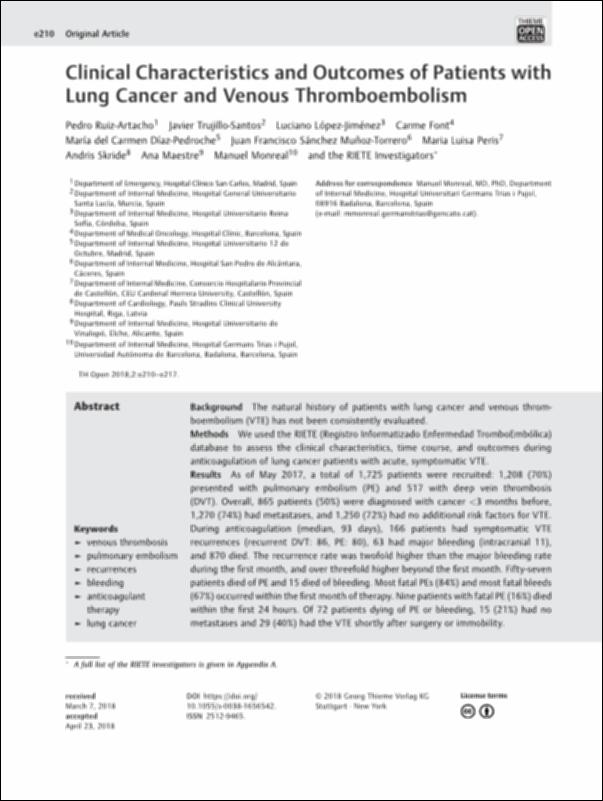Please use this identifier to cite or link to this item:
http://hdl.handle.net/10637/10458Clinical characteristics and outcomes of patients with lung cancer and venous thromboembolism
| Title: | Clinical characteristics and outcomes of patients with lung cancer and venous thromboembolism |
| Authors : | Ruiz Artacho, Pedro Trujillo Santos, Javier López Jiménez, Luciano Font Puig, Carme Díaz Pedroche, María del Carmen Sánchez Muñoz-Torrero, Juan Francisco Peris Sifre, María Luisa Skride, Andris Maestre Peiró, Ana Monreal Bosch, Manuel |
| Keywords: | Pulmones - Cáncer - Tratamiento.; Lungs - Cancer - Treatment.; Anticoagulantes - Uso terapéutico.; Cardiovascular system - Diseases - Treatment.; Anticoagulants (Medicine) - Therapeutic use.; Aparato circulatorio - Enfermedades - Tratamiento. |
| Publisher: | Georg Thieme |
| Citation: | Ruiz Artacho, P., Trujillo-Santos, J., López-Jiménez, L., Font, C., Díaz-Pedroche, MC., Sánchez Muñoz-Torrero, JF. et al. (2018). Clinical characteristics and outcomes of patients with lung cancer and venous thromboembolism. TH Open, vol. 2, n. 2, pp. e210-e217. DOI: https://doi.org/10.1055/s-0038-1656542 |
| Abstract: | Background: The natural history of patients with lung cancer and venous thromboembolism (VTE) has not been consistently evaluated. Methods: We used the RIETE (Registro Informatizado Enfermedad TromboEmbólica) database to assess the clinical characteristics, time course, and outcomes during anticoagulation of lung cancer patients with acute, symptomatic VTE. Results: As of May 2017, a total of 1,725 patients were recruited: 1,208 (70%) presented with pulmonary embolism (PE) and 517 with deep vein thrombosis (DVT). Overall, 865 patients (50%) were diagnosed with cancer <3 months before, 1,270 (74%) had metastases, and 1,250 (72%) had no additional risk factors for VTE. During anticoagulation (median, 93 days), 166 patients had symptomatic VTE recurrences (recurrent DVT: 86, PE: 80), 63 had major bleeding (intracranial 11), and 870 died. The recurrence rate was twofold higher than the major bleeding rate during the first month, and over threefold higher beyond the first month. Fifty-seven patients died of PE and 15 died of bleeding. Most fatal PEs (84%) and most fatal bleeds (67%) occurred within the firstmonth of therapy. Nine patients with fatal PE (16%) died within the first 24 hours. Of 72 patients dying of PE or bleeding, 15 (21%) had no metastases and 29 (40%) had the VTE shortly after surgery or immobility. Conclusion: Active surveillance on early signs and/or symptoms of VTE in patients with recently diagnosed lung cancer and prescription of prophylaxis in those undergoing surgery or during periods of immobilizationmight likely help prevent VTE better, detect it earlier, and treat it more efficiently. |
| URI: | http://hdl.handle.net/10637/10458 |
| Rights : | http://creativecommons.org/licenses/by/4.0/deed.es |
| ISSN: | 2512-9465. |
| Issue Date: | 1-May-2018 |
| Center : | Universidad Cardenal Herrera-CEU |
| Appears in Collections: | Dpto. Medicina y Cirugía |
Items in DSpace are protected by copyright, with all rights reserved, unless otherwise indicated.


